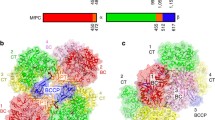Abstract
We have isolated and purified enolase fromClostridium difficile. This is the first report of an enolase of theClostridium genus, and in general its characteristics resemble those described previously for other species, except that it is extremely thermostable. Interestingly,C. difficile enolase has an octameric structure (approximately 300 kDa on native PAGE, 50 kDa on SDS PAGE, and 338 kDa by gel filtration). Enolases fromC. sordellii andC. bifermentans have been partially purified and have a molecular weight similar to that ofC. difficile. It may be that this large size is common for enolases isolated from bacteria of theClostridium genus.
Similar content being viewed by others
Literature Cited
Barnes DB, Stellwagen E (1973) Enolase from the thermophileThermus X-1. Biochemistry 12:1559–1565
Barroso LA, Wang S-Z, Phelps CJ, Johnson JL, Wilkins TD (1990) Nucleotide sequence ofClostridium difficile toxin B gene. Nucleic Acids Res 18:4004
Bisseret F, Keith G, Rihn B, Amiri I, Werneburg B, Girardot R, Baldacini O, GreenG, Nguyen VK, Monteil H (1989)Clostridium difficile toxin B: characterization and sequence of three peptides. J Chromatogr 49:91–100
Bradford MM (1976) A rapid and sensitive method for the quantitation of microgram quantities of proteins utilizing the principle of protein dye binding. Anal Biochem 72:248–254
Dannelly HK, Reeves HC (1988) Purification and characterization of enolase fromEscherichia coli. Curr Microbiol 17:265–268
Dutta SK, Verma M (1987) Isolation and characterization of non-neuronal enolase (NNE) fromNeurospora crassa and comparison with neuron specific enolase isolated from neuroblastoma cell line NG108. Biochem Intern 15:223–234
Holland MJ, Holland JP, Thill GP, JacksonKA (1981) The primary structures of two yeast enolase genes. J Biol Chem 256:1385–1395
Huther FJ, Psarros N, Duschner H (1990) Isolation, characterization, and inhibition kinetics of enolase fromStreptococcus rattus FA-1. Infect Immun 58:1043–1047
Johnson JL, Phelps C, Barroso L, Roberts MD, Lyerly DM, Wilkins TD (1990) Cloning and expression of the toxin B gene ofClostridium difficile. Curr Microbiol 20:397–401
Knoop F, Martig RM, Owens M (1990) Degradation of 2-phosphoglycerate by cytotoxin B ofClostridium difficile. FEBS Lett 267:9–12
Lamandé N, Mazo AM, Lukas M, Montarras D, Pinset C, Gros F, Legault-Demare L, Lazar M (1989) Murine musclespecific enolase: cDNA cloning, sequence, and developmental expression. Proc Natl Acad Sci USA 86:4445–4449
Lebioda L, Boguslaw, S (1988) Crystal structure of enolase indicates that enolase and pyruvate kinase evolved from a common ancestor. Nature 333:683–685
Lebioda L, Boguslav S, Brewer JM (1989) The structure of yeast enolase at 2.25-Å resolution. J Biol Chem 264: 3685–3693
Nguyen VK, Rihn B, Heckel C, Bisseret F, Girardot R, Monteil H (1990) Enzyme immunoassay (ELISA) for detection ofClostridium difficile toxin B in specimens of faeces. J Med Microbiol 31:251–257
Ohshima Y, Mitsui H, Taxayama Y, Kushiya E, Saximura K, Takahashi Y (1989) cDNA cloning and nucleotide sequence of rat muscle-specific enolase (ββ enolase). FEBS Lett 242:425–430
Oliva D, Barba G, Barbieri G, Giallongo A, Fes S (1989) Cloning, expression and sequence homologies of cDNA for human gamma enolase. Gene 79:355–360
Pawluk A, Scopes RK, Griffiths-Smith K (1986) Isolation and properties of the glycolytic enzymes fromZymomonas mobilis. Biochem J 238:275–281
Rihn B, Bisseret F, Girardot R, Scheftel, JM, Nguyen VK, Monteil H (1988) Fast protein purification ofClostridium difficile cytotoxin. J Chromatogr 428:408–414
Segil N, Shrutkowski A, Dworkin MB, Dworkin-Rastl E (1988) Enolase isoenzymes in adult and developingXenopus laevis and characterization of a cloned enolase sequence. Biochem J 251:31–39
Singh RP, Setlow P (1978) Enolase from spores and cells ofBacillus megaterium: two-step purification of the enzyme and some of its properties. J Bacteriol 134:353–355
Stellwagen E, Cronlund MM, Barnes LD (1973) A thermostable enolase from the extreme thermophileThermus aquaticus YT-1. Biochemistry 12:1552–1559
Van Der Straeten D, Rodrigues-Pousada RA, Goodman HM, Van Montagu M (1991) Plant enolase: gene structure, expression and evolution. Plant Cell 3:719–735
Verma M (1989) Primary structure ofBacillus subtilis enolase gene deduced from c-DNA sequence. Biochem Intern 18:667–672
Wold F (1971) In: Bayer PD (ed) The enzymes. New York: Academic Press, pp 499–538
Author information
Authors and Affiliations
Rights and permissions
About this article
Cite this article
Green, G.A., Girardot, R., Baldacini, O. et al. Characterization of enolase fromClostridium difficile . Current Microbiology 26, 53–56 (1993). https://doi.org/10.1007/BF01577243
Issue Date:
DOI: https://doi.org/10.1007/BF01577243




